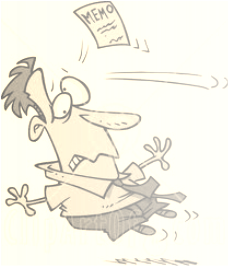Proposal / Memo

ü A proposal memo (or memorandum) is a written message in business, usually sent internally.
ü The main purpose of a memo is to solve problems, either by informing the reader about new information, like policy changes, price increases, etc., or by persuading the reader to take an action, such as attend a meeting, use less paper, or change a current production procedure.
ü Standard memos can be divided into the following 4 parts to organise the information and to help achieve the writer’s purpose:
TO: (readers’ names and job titles) *
FROM: (your name and job title)
DATE: (complete and current date)
SUBJECT: (what the memo is about) **
* Make sure you address the reader by his or her correct name and job title. You might call the company president Jonesy on the golf course or in an informal note, but Mary Jones, President would be more appropriate for a formal memo.
** Be specific and concise in your subject line. For example, Rats as a subject line is far too vague. Instead use something like, Eradicating Warehouse of Rat Problem.
2. Opening
Provide the purpose of the memo (give your reason for writing it and forecast what is in the rest of the memo), the context (i.e. the event, circumstance and background) and problem, and the specific assignment or task (describe what you are doing to help solve the problem). Include only as much information as is needed by the decision-makers in the context, but be convincing that a real problem exists. Do no ramble on with insignificant details.
3. Main body
Include the details that support your ideas. Here you want to think of an inverted pyramid. Start with your most general information and move to your specific or supporting facts. For easy reading, put important points or details into lists rather than paragraphs when possible.
4. Conclusion
After the reader has absorbed all of your information, you want to close with a courteous ending that states what action you want your reader to take. Make sure you consider how the reader will benefit from the desired actions and how you can make those actions easier. For example, you might say, I will be glad to discuss this recommendation with you at our Tuesday meeting, and follow through on any decisions you make.
ü The main purpose of a memo is to solve problems, either by informing the reader about new information, like policy changes, price increases, etc., or by persuading the reader to take an action, such as attend a meeting, use less paper, or change a current production procedure.
ü Standard memos can be divided into the following 4 parts to organise the information and to help achieve the writer’s purpose:
- Heading
TO: (readers’ names and job titles) *
FROM: (your name and job title)
DATE: (complete and current date)
SUBJECT: (what the memo is about) **
* Make sure you address the reader by his or her correct name and job title. You might call the company president Jonesy on the golf course or in an informal note, but Mary Jones, President would be more appropriate for a formal memo.
** Be specific and concise in your subject line. For example, Rats as a subject line is far too vague. Instead use something like, Eradicating Warehouse of Rat Problem.
2. Opening
Provide the purpose of the memo (give your reason for writing it and forecast what is in the rest of the memo), the context (i.e. the event, circumstance and background) and problem, and the specific assignment or task (describe what you are doing to help solve the problem). Include only as much information as is needed by the decision-makers in the context, but be convincing that a real problem exists. Do no ramble on with insignificant details.
3. Main body
Include the details that support your ideas. Here you want to think of an inverted pyramid. Start with your most general information and move to your specific or supporting facts. For easy reading, put important points or details into lists rather than paragraphs when possible.
4. Conclusion
After the reader has absorbed all of your information, you want to close with a courteous ending that states what action you want your reader to take. Make sure you consider how the reader will benefit from the desired actions and how you can make those actions easier. For example, you might say, I will be glad to discuss this recommendation with you at our Tuesday meeting, and follow through on any decisions you make.
